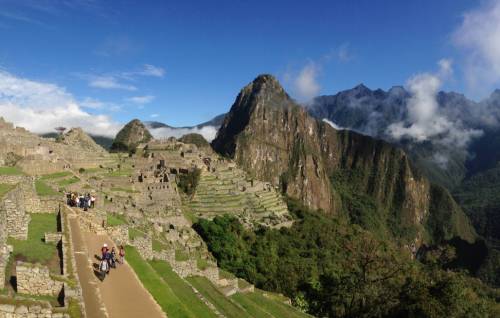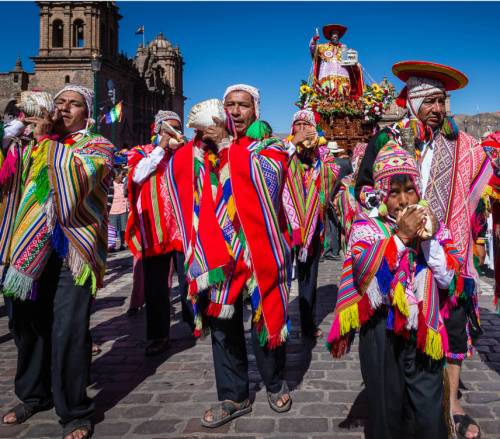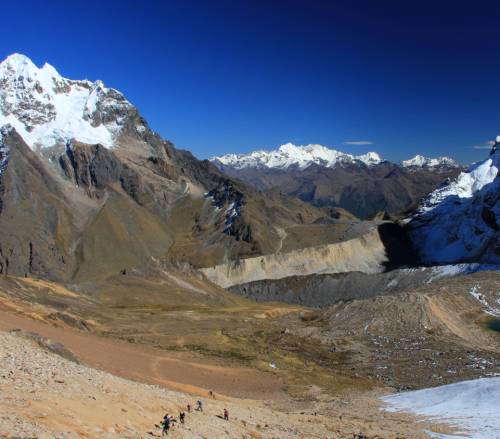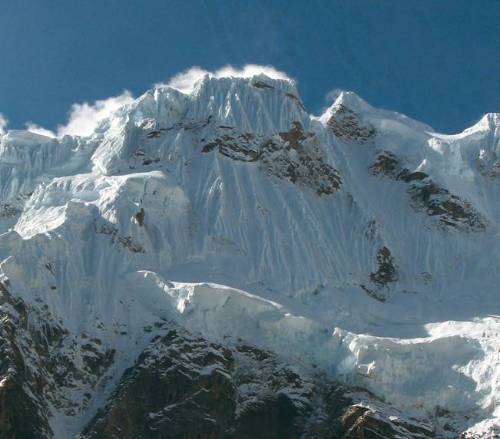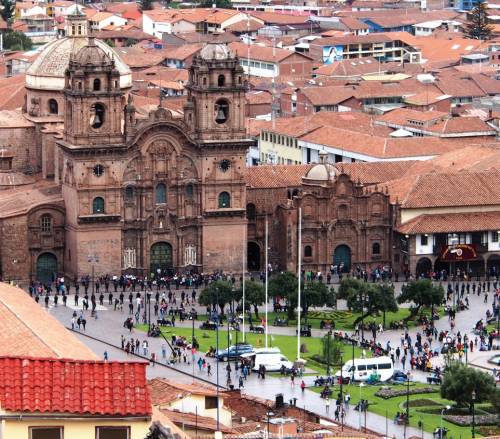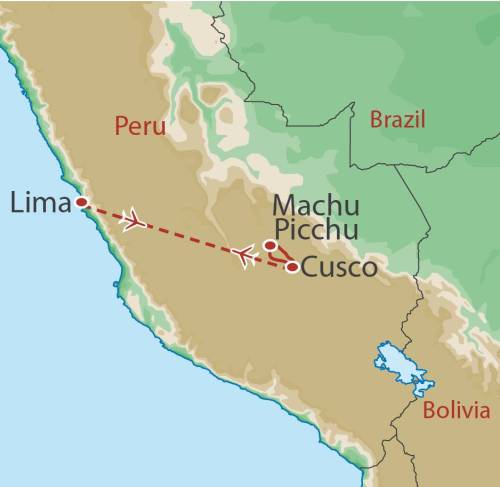Salkantay Base Camp to Machu Picchu Trek
Salkantay Base Camp to Machu Picchu Trek
$2990
Salkantay Base Camp to Machu Picchu Trek
15 Days Starting in Lima and ending in
Visiting: Peru
Tour operator:
Tour code:
AAD
Group size:
4 - 16
Trip Styles:
Interests:
Activities:
Tour Overview
The soaring peaks of the Andes and the cultural legacies of the Incas are two of Peru’s most compelling attractions. We discover both and much more on this amazing two-week adventure. After savouring the historical and cultural highlights of Cusco and the Sacred Valley of the Incas while we take our time acclimatising, we commence our trek. This little-visited trail takes us through breathtaking mountain scenery as we make our way to the foothills of the majestic snow-capped peaks of Salkantay, Humantay and Huayanay. For a week we explore the stunning wilderness of the Peruvian Andes, following trails to 5,000 m in the Cordillera Vilcabamba and establishing camp beneath the spectacular 6,220m Mount Salkantay. This stunning trail is much quieter than the busier Inca Trail and is highly regarded by past trekkers. On the final day we join the classic Inca Trail for the unforgettable sight of Machu Picchu from the ‘Sun Gate’. Rather than rushing back to Cusco, we spend a night in nearby Aguas Calientes for a well-deserved soak in the local hot springs before heading back to Machu Picchu the next day at the best time, as the sun is rising over these dramatic ruins. If you’re looking for an unforgettable encounter with Peruvian culture, history and wilderness—one that gets you off the beaten track but takes in the must-see sights of Cusco, the Sacred Valley of the Incas and Machu Picchu—then this is the adventure for you!
Highlights
Itinerary
Day 1 : Arrive Lima
You will be met at the airport and transferred to the hotel where you are free to rest in the hotel or just wander around Miraflores, the area of Lima where our hotel is located. Some of Lima’s best galleries and shops and restaurants are located in this area. Founded by Francisco Pizarro in 1535, Lima is the oldest capital in South America, with a superb combination of Spanish Colonial and 19th century European architecture. If you have time to visit a museum we would recommend the brilliant Larco Herrera Museum which also has an excellent onsite restaurant or the Museo de La Nacion or the Larco Herrera Museum.
Overnight: Hotel Dazzler by Wyndham Miraflores or similar.
Day 2 : Fly To Cusco
Transfer to Lima airport and fly to Cusco (if you organise your own flights, please ask us for the group flight details before you book flights, otherwise additional airport transfer costs will apply). Try to get a seat on the left side of the aircraft for the best views of stunning snow peaks. After your transfer to our hotel located in the historic centre you will have some time to explore the city and also enjoy a few hours of rest, essential to initiate successful acclimatisation to the altitude. In the evening you will meet with your guide at 6pm at your hotel for an initial trip briefing and receive your kitbags and jackets for your trek.
Overnight: Casa Andina Standard Cathedral or similar.
Day 3 : Tour Of Cusco And The Nearby Ruins
Today we have a guided tour of Cusco and its nearby ruins. The city, once capital of the extensive Inca Empire, has seen many changes since Francisco Pizarro's men took the city with such apparent ease in November 1533. The tour starts with a visit to Santo Domingo Convent, a large Renaissance-baroque complex, which was built over the Inca Coricancha temple. It was one of the most important temples dedicated to worshipping of the sun, and its foundations are still prominent at the base of the convent. Ancient chronicles say the temple was covered in gold leaf and filled with golden representations of nature. Then, visit the Cathedral, the most famous monument of the Main Square. Head to the hills above Cusco to visit the remains of the fortress of Sacsayhuaman. The impressive ramparts offer a stunning panoramic view of Cusco, and the ruins of the temple and amphitheatre of Qenqo, where it is believed the Incas practised agricultural rituals. Admire Qenqo and then finally visit Puka Pukara (‘Red fortress’ in Quechua), an Inca military complex located on a prominent hill. Its dwellings, squares, bathrooms, aqueducts, walls, and towers can still be appreciated. Afterwards, we return to our hotel. In the afternoon you may have time to explore some of the central parts of the city and have a chance to look at some of the great varieties of local craft work on sale in open-air artisan markets and shops.
Overnight: Casa Andina Standard Cathedral or similar.
Day 4 : To Sacred Valley Of The Incas
We leave Cusco and head to the Chinchero Plateau to explore Chinchero, an important town in Inca times. The most striking remnant of this period is the massive stone wall in the main plaza which has ten trapezoidal niches. There are beautiful views overlooking the Sacred Valley of the Incas, with the Cordillera Vilcabamba and the snow-capped peak of Salkantay dominating the western horizon. Chinchero is believed to be the mythical birthplace of the rainbow. Next we visit the mysterious concentric circular terraces of Moray which, according to some scholars, could have been an agricultural research centre. From here we head to the salt mines of Maras. This village is a salt-producing centre that dates back all the way to pre-Inca times. There are thousands of salt pools all carved into the mountain side. Due to a change in regulations, visitors are not allowed to walk through the salt mine anymore to avoid contamination of the salt. We will go to a lookout point from where we have stunning views of the salt pools. From here we will walk for about 1 hour mainly downhill to Pichingoto. Enjoy this rarely walked path and soak up the incredible setting of the Sacred Valley. Our car will be waiting for us in Pichingoto and we drive to our hotel in Ollantaytambo. The rest of the afternoon is free to relax and enjoy the beauty of this famous town.
Overnight: Sol Ollantay Hotel or similar.
Day 5 : In Sacred Valley Of The Incas
Today we enjoy another day in this beautiful place. The valley actually follows the course of the famous Urubamba River, one of the main tributaries of the Amazon River. During our time in Ollantaytambo we visit its remarkable temple/fortress set high on a ridge above the village. The village itself is a fascinating mixture of Inca and Colonial architecture. If the weather is good and we have time we can enjoy some short walks in the valley - a good way to prepare for the trek ahead. This evening we have a pre-trek briefing with our trekking guide at our hotel and prepare for the trek.
Overnight: Sol Ollantay Hotel or similar.
Day 6 : Drive To Challacancha, Commence Trek (Trekking Approx 4-6Hrs)
Today we have an early start as we begin our scenic 5-hour drive north to our trailhead at Challacancha, where we will meet up with our team of muleskinners and their pack animals to start our 7-day trek towards Salkantay and Machu Picchu! After a picnic lunch we start hiking steadily uphill towards our first night’s campsite close to Soraypampa at approximately 3,700m. Today we’ll get our first glimpse of Salkantay’s sister peak, Humantay (5,950 m / 19,700 ft). If time allows, we will also walk up to Lake Humantay, a beautiful blue lagoon with snow capped mountains in the background.
Overnight: Campsite.
Day 7 : Trek Up The Valley Between Salkantay And Humantay (Trekking Approx 4-7Hrs)
This morning we’ll be woken early with hot tea brought to our tents and after breakfast we’ll get an early start on our day’s hiking. Depending on weather conditions and the group's preference, we'll hike up to beautiful Humantay Lake early in the morning (4,221m). We will return to Soraypampa and from here, we’ll hike for about 3 hours, steadily gaining altitude, before stopping for a lunch break at Salkantay Pampa (4,150 m / 13,600 ft), set in front of an enormous mass of glacial moraine. After a rest we continue on for 2-3 hours of steady hiking towards at our next camp of Ichupata (4,400 m / 14,400 ft), set on the flanks of the majestic peak of Mt Salkantay (6,271m / 20,574 ft), which dominates the skyline for most of our trekking days. The camp at Ichupata is cold due to its proximity to the Salkantay massif, but since our cooks and pack animals will have set out earlier, we should find the camp already set up and a fresh pot of hot tea awaiting our arrival!
Overnight: Campsite.
Day 8 : Trek Over Incachiriasca Pass To Acobamba (Trekking Approx 7-8Hrs)
After a hearty cooked breakfast we set off to hike across one of Salkantay’s ridges and over the mountain pass of Incachiriasca. At an elevation of 4,870 m / 15,970, Incachiriasca is the highest pass of our trek, offering us spectacular views of our dramatic surroundings. After a stop at the pass to rest and take photos, we head down to follow the ancient trail to our next camp at Acobamba, set on a lovely little plateau above Sisaypampa.
Overnight: Campsite.
Day 9 : Descend To Paucarcancha And Up To The Village Of Q’Esca (Trekking Approx 7-8Hrs)
From Acobamba we descend into the scenic Pampacahuana valley, passing simple shepherd’s homes and scattered communities, and stopping to visit the extensive Incan ruins of Paucarcancha (3,350 m / 11,000 ft). From here we trek up the valley towards the Ancascocha Pass. Tonight we camp just above the small village of Q’esca, home to shepherds and potato farmers. (We might also consider staying higher up and taking an alternative route to Q’esca).
Overnight: Campsite.
Day 10 : Trek Over The Ancascocha Pass (Trekking Approx 6-7Hrs)
Another early morning today as we begin our climb up to the second high mountain pass of our trek, the Ancascocha Pass (4,695 m / 15,400 ft). From here we begin a steady descent, hiking through dramatic mountain scenery and passing two pretty alpine lakes known for their large trout. Tonight we camp near the small farming village of Ancascocha.
Overnight: Campsite.
Day 11 : Descend To The Sacred Valley At Chilca (Trekking Approx 5-6Hrs)
From Ancascocha we head down a narrow valley whose rivers run right down into the mighty Amazon. As we descend, the sparse alpine vegetation begins to change and we start to encounter larger trees—a good chance to spot some of the most common Andean birds in this region: the black-throated flowerpiercer, great sapphirewing, rusty-fronted canastero, creamy-crested spinetail, and, if we remember to look up, the endangered Andean condor—among the largest and heaviest flying birds in the world. Near the end of our day’s trek, we reach Hatunrumiyoq from where we’ll have incredible views of the rugged snow-capped peak of Mt Veronica (5,980 m / 19,500 ft). Tonight we camp near the large village of Chilca, and if time permits, our cooks will prepare a special ‘Pachamanca’—a traditional Peruvian feast of meat and vegetables cooked in the ground using hot stones. A good night’s sleep at this lower altitude will put us in good stead for tomorrow’s trek along the Inca Trail to Machu Picchu.
Overnight: Campsite.
Day 12 : Trek To Machu Picchu (Trekking Approx 5-7Hrs)
After an early breakfast we hike down to the railway at Chilca (4km) for a short drive to Ollantaytambo train station where you'll embark on a journey to KM 104 the start of our trek. Upon crossing the suspension bridge over the Urubamba River, we visit the archaeological gem of Chachabamba (2,150m). The trail then ascends, going through 8km of lush forested paths over approximately 4 hours, guiding us to the awe-inspiring site of Wiñayhuayna (2,700m). This remarkable complex showcases the ingenuity of Incan architecture, with its expansive agricultural terraces, sacred religious areas, and a well-preserved urban sector.
After a box lunch we continue for about an hour towards 'Inti Punku '(the 'Sun Gate'), (2,730m). It is here that you'll be rewarded with your first breathtaking glimpse of Machu Picchu (2,430m). After a brief look at the site from above we head down by bus to our hotel in Aguas Calientes for a well-deserved soak in the nearby hot springs (optional).
Overnight: El Mapi Hotel or similar. Walking Approx 12 km, 5 - 7 hours, max elevation 2745m
PLEASE NOTE: All trekking distances and walking hours per day are approximate and the length, distance per day, start and finish time can vary depending on the group size, ability and weather conditions.
Day 13 : Explore Machu Picchu, Return To Cusco
Today we start early to explore these remarkable and truly enigmatic ruins. We will enjoy a guided tour of the sanctuary. In the afternoon or early evening we depart from Machu Picchu for the train ride back to Ollantaytambo where we transfer to our vehicle for the drive back to Cusco. Here we transfer to our hotel for two nights.
Overnight: Casa Andina Cathedral Hotel or similar.
NB: Depending on train schedules, we may arrive into Cusco very late at night.
*Important: To ensure the protection and conservation of the Inca citadel of Machu Picchu and enhance the visitor experience, several restrictions and regulations are in place. The site features three main circuits divided into ten predetermined routes. Visitors are limited to a maximum of four hours within the site to reduce congestion and preserve the ruins, and admission is not permitted after 4pm. Additionally, all visitors must be accompanied by a guide. Despite these restrictions, World Expeditions endeavours to ensure you have a memorable and fulfilling Machu Picchu experience.
OPTIONAL HUAYNA PICCHU CLIMB OR MACHU PICCHU MOUNTAIN CLIMB - For the adventurous, you can purchase a permit for Huayna Picchu or Machu Picchu Mountain climb (ask for costs) and forego the guided tour of Machu Picchu, which is non-refundable and non-transferable. Both climbs are steep, slippery, and exposed with vertiginous drops. Huayna Picchu has narrow trails and reaches 2,963m, while Machu Picchu Mountain has a wider path and reaches 3,082m. The climbs are not guided and takes a minimum of 3 hours return. Before purchasing the non-refundable and non-transferable permit, passengers must sign a waiver form. There are limited Huayna Picchu permits available and they sell out quickly, so contact us as soon as possible if interested.
Day 14 : Cusco - Free Day
Today we have a free day in Cusco to relax and repack after our trek, or to enjoy a spot of souvenir shopping, choosing from a huge variety of expertly made Peruvian craft work—including alpaca sweaters and hats, vibrant textiles and weavings, ceramics and traditional Andean instruments.
Overnight: Casa Andina Cathedral Hotel or similar.
Day 15 : Drive To Cusco Airport, Trip Concludes
After breakfast we are transferred to the airport in Cusco where our trip concludes.
What's Included
-
Accommodation
8 nights hotel -
14 breakfasts, 7 lunches and 6 dinners
-
Airport transfers if arriving/departing on first or last day
-
Entrance to Machu Picchu
-
Expert bilingual guide
-
Group medical kit
-
Comfortable and central hotels primarily Casa Andina Classic hotels
-
Private internal transportation
-
The use of a gear pack including sleeping bag, fibre filled jacket, thermarest and headtorch
-
Group camping equipment & porters to carry personal gear
-
Sightseeing and site entrance fees as listed (including Machu Picchu entrance fee)
Accommodation
8 nights hotel
While in Lima or Cusco, you will typically stay at a Casa Andina hotel, or another property of a similar style. The Casa Andinas specialise in integrating the characteristics of each destination such as architecture, decoration, gastronomy and music to create an authentic experience for our travellers. They are centrally located and come with good service and comfort. Most of the hotels and lodges we use can be described as 3 star accommodation, some of them are categorised as 4 stars. In smaller towns and villages hotel options are often limited and we might have to use more basic accommodation with a lower or without star rating. Please note that the star rating in South America is very fluid and can’t be compared to a western standard star rating, however you can be assured of clean, comfortable and well located lodgings.
During the trekking section, enjoy our fully supported camping experience in quality two person tents with plenty of personal space and storage for your luggage. Our team are on hand to ensure your comfort and safety with a dining tent, separate cooking tent and where appropriate, toilet tent erected.
What You Carry
In your daypack you will need to carry extra warm clothing, a rainjacket, water bottle, camera gear, valuables and personal items such as sunscreen, lip-eze etc. Porters and mules carry all group gear and your trek pack. Please note, the following items are prohibited in Machu Picchu: drones, selfie sticks, tripod for cameras, walking stick without rubber tip, backpack that exceeds 40cm x 35cm x 20cm, aerosol spray, heals, sharp objects, banners or posters. As of December 2018, single-use plastic bottles and any other single-use plastics (bags, cups, straws, etc) are prohibited in the Historic Sanctuary of Machu Picchu, on the Inca Trail and all other protected natural areas in Peru. This regulation was established by the Ministry of Environment, following the Sustainable Tourism Regulation which aims to conserve these protected natural areas. Please ensure to bring your reusable water bottle on all our Peru trips. Water refill stations have been installed in areas near Machu Picchu and other national parks. Your guide will brief you where you can refill your water bottles with drinking water.
Grading
This trip is graded moderate and is suitable for fit and healthy people. Prior trekking is not necessary, although you would be expected to be comfortable in the outdoors and camping for successive periods. These adventures involve trekking for up to 6 - 8 hours a day at a steady pace. These trips may spend successive days at altitudes not generally exceeding 5,500m and are usually between 10 and 15 days in duration. You will need a good level of fitness and be in good health.
* Suggested preparation: One hour of aerobic type exercise, three to five times a week for the three months leading up to your trip. Hill walking with a pack in variable weather conditions is also recommended. To prepare for a walking holiday we recommend you take every opportunity to walk up and down stairs and/or hills, for leg strengthening and aerobic fitness. Please remember the fitter you are the more you will enjoy your holiday.
What You Carry
In your daypack you will need to carry extra warm clothing, a rainjacket, water bottle, camera gear, valuables and personal items such as sunscreen, lip-eze etc. Porters and mules carry all group gear and your trek pack.
Please note, the following items are prohibited in Machu Picchu: drones, selfie sticks, tripod for cameras, walking stick without rubber tip, backpack that exceeds 40cm x 35cm x 20cm, aerosol spray, heals, sharp objects, banners or posters. As of December 2018, single-use plastic bottles and any other single-use plastics (bags, cups, straws, etc) are prohibited in the Historic Sanctuary of Machu Picchu, on the Inca Trail and all other protected natural areas in Peru. This regulation was established by the Ministry of Environment, following the Sustainable Tourism Regulation which aims to conserve these protected natural areas. Please ensure to bring your reusable water bottle on all our Peru trips. Water refill stations have been installed in areas near Machu Picchu and other national parks. Your guide will brief you where you can refill your water bottles with drinking water.
Check out our Q&As
-
What type of accommodation can I expect during the trek?
During the trek, you will enjoy a fully supported camping experience in quality two-person tents. The camping setup includes a dining tent, a separate cooking tent, and where appropriate, a toilet tent. The team is on hand to ensure your comfort and safety.
-
Are there any restrictions on items I can bring to Machu Picchu?
Yes, there are several restrictions on items you can bring to Machu Picchu. Prohibited items include drones, selfie sticks, tripods for cameras, walking sticks without rubber tips, backpacks exceeding 40cm x 35cm x 20cm, aerosol sprays, heels, sharp objects, banners or posters, and single-use plastics such as bottles, bags, cups, and straws.
-
What is the highest point we will reach during the trek?
The highest point during the trek is the Incachiriasca Pass, which is at an elevation of 4,870 meters (15,970 feet).
-
What kind of physical preparation is recommended for this trek?
This trek is graded moderate and is suitable for fit and healthy people. It is recommended to engage in one hour of aerobic exercise three to five times a week for the three months leading up to the trip. Hill walking with a pack in variable weather conditions is also advised to prepare for the trek.
-
What should I carry in my daypack during the trek?
In your daypack, you should carry extra warm clothing, a rain jacket, a water bottle, camera gear, valuables, and personal items such as sunscreen and lip balm. Porters and mules will carry all group gear and your trek pack.
-
Who will be my travelling companions on the tour?
We have offices on three continents which means your travelling companions will be just that – international and wonderfully eclectic. Part of small group travel means that although travellers come from various locations and backgrounds, you will be travelling with like-minded companions who, like you, are keen to share the experience and forge lifelong friendships.
-
What about environmental impact?
We believe that adventure travel revolves around establishing a strong relationship with the people and environments in which we operate. Our responsible travel policies have been carefully developed to ensure that we minimise the impact of our presence and help to protect the regions we visit while contributing positively to the local community.
-
What should I pack?
Your pre-departure documents include a detailed packing list with items that you need to bring. While most of the equipment for daily activities is included in your tour cost, some items like helmets and hiking boots are best brought from home. The pre-departure documents also include information on layering and recommended brands for various items to ensure you are fully prepared for your trip.
-
Do you operate a “single share” option and how does it work?
Yes. World Expeditions does not require single travellers to pay a surcharge for travelling alone on the vast majority of our trips. Our holidays are primarily on a twin share basis, so if you are joining the group as a solo traveller, we will match you with someone of your own gender. The choice is yours however; if you prefer not to share, we do offer single supplements for private occupancy.
-
Are tips included in my trip price?
Tips are not included in the tour cost. Tipping is a personal thing, do not worry about how much, or when, to tip. Tipping guidelines are provided for certain destinations in our pre departure information upon booking, however the best advice will be provided by your tour leader.
-
Am I suited to small-group travel?
We recognise that many of our travellers have not been on a ‘group trip’ before. Yet what our departures provide is both structure and flexibility, allowing you plenty of freedom within the framework of the itinerary. You’ll find that with our maximum group size at 16, you’ll travel in a minimal impact style with a great group of like-minded travellers.
-
Can you advise which vaccinations are recommended?
While our pre-departure kit provides information on vaccinations, we suggest that you consult your doctor, local government inoculation centre or a travel medical specialist in order to get the most current advice regarding vaccination requirements.
Reviews from travellers on this tour
1 Select your preferred date
Monday - Monday
Apr 21, 2025 - May 05, 2025Book with Confidence
-
Transfer as credit to Future Tours
World Expeditions allows you to transfer existing payments to a future tour to avoid cancellation fees if you can't travel and inform world expeditions, 70 days before departure.
-
Low Deposit
World Expeditions requires a minimum deposit of 400 GBP per person or the full booking value, whichever is less, with the final balance not due until 70 days before departure.
-
Cancellation Policy
We don't charge a cancellation fee, here is a summary of world expeditions charges.
Up to 70 days before tour starts: Forfeit 100% of deposit.
At 69 days before tour starts: Forfeit 50% of booking price.
At 35 days before tour starts: Forfeit 100% of booking price.
